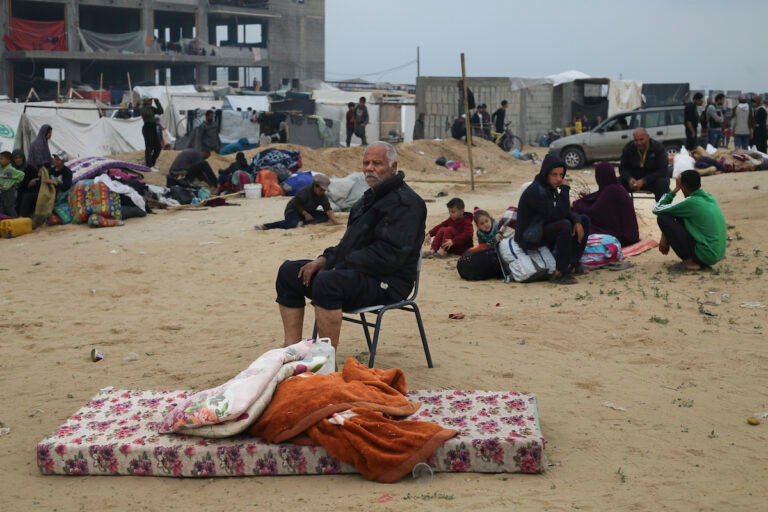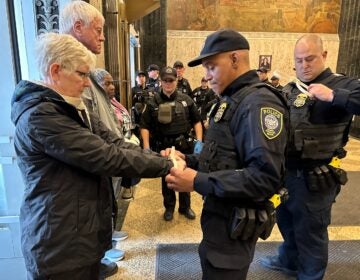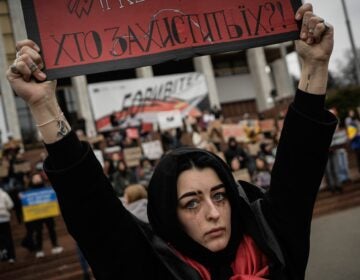Israel moves into Gaza’s second-largest city and intensifies strikes in bloody new phase of the war
The military says its forces are “in the heart” of Khan Younis, which has emerged as the first target in the expanded ground offensive into southern Gaza.

Palestinians fleeing the Israeli ground offensive arrive in Rafah, Gaza Strip, Tuesday, Dec. 5, 2023. (AP Photo/Hatem Ali)
Israel said Tuesday that its troops had entered Gaza’s second-largest city as intensified bombardment sent streams of ambulances and cars racing to hospitals with wounded and dead Palestinians, including children, in a bloody new phase of the war.
The military said its forces were “in the heart” of Khan Younis, which has emerged as the first target in the expanded ground offensive into southern Gaza that Israel says aims to destroy Hamas. Military officials said they were engaged in the “most intense day” of battles since the ground offensive began more than five weeks ago, with heavy firefights also taking place in northern Gaza.
The assault into the south is pushing a new wave of displaced Palestinians almost two months into the war, raising alarm from relief groups that they can’t keep up because insufficient aid supplies are entering Gaza. The U.N. said 1.87 million people — more than 80% of Gaza’s population — have been driven from their homes. New evacuation orders by the Israeli military are squeezing people into ever-smaller areas of the tiny coastal strip’s southern portion.
Bombardment has grown fiercer across the territory, including areas where Palestinians are told to seek safety. In the central Gaza town of Deir al-Balah, just north of Khan Younis, a strike Tuesday destroyed a house where dozens of displaced people were sheltering. At least 34 people were killed, including at least six children, according to an Associated Press reporter at the hospital who counted the bodies.
Footage from the scene of the strike showed women screaming from an upper floor of a house shattered to a concrete shell. In a field of wreckage below, men pulled the limp body of a child from under a concrete slab next to a burning car. At the nearby hospital, medics tried to resuscitate a young boy and girl, placed together bloodied and unmoving on a single stretcher.
Under U.S. pressure to prevent further mass casualties in the conflict with Hamas, Israel says it is being more precise as it widens its offensive into southern Gaza. Weeks of bombardment and a ground offensive obliterated much of northern Gaza.
Israel says it must dismantle Hamas’ extensive military infrastructure and remove it from power to prevent a repeat of the Oct. 7 attack that ignited the war. In the surprise attack, Hamas and other Palestinian militants killed about 1,200 people, mostly civilians, and took captive some 240 men, women and children.
The military accuses Hamas of using civilians as human shields as the militants fight in dense residential areas, where they have tunnels, bunkers, rocket launchers and sniper nests.
Israel’s assault since Oct. 7 has killed more than 15,890 people in Gaza — 70% of them women and children — with more than 42,000 wounded, according to the Health Ministry in Gaza. The ministry does not differentiate between civilian and combatant deaths. It says hundreds have been killed or wounded since a weeklong cease-fire ended Friday, and many still are trapped under rubble.
Battles in Khan Younis and North Gaza
Israel military Chief of Staff Herzi Halevi said his forces had begun the “third phase of the ground operations,” moving against Hamas in the south after seizing much of the north and “severely damaging Hamas.”
Israel has not given details on troops movements, and it was not clear how far they had moved into Khan Younis. Residents said troops had advanced to Bani Suheila, a town on the city’s eastern edge.
Israeli forces also appear to be moving to partially cut across the strip between Khan Younis and Deir al-Balah. Satellite photos from Sunday showed around 150 Israeli tanks, armored personnel carriers and other vehicles on the main road between the two cities.
The past days have brought some of the heaviest bombardment of the entire war, the U.N.’s humanitarian affairs office OCHA said.
Witnesses said a strike Tuesday hit a school in Khan Younis where hundreds of displaced people were sheltering. Ambulances rushed dozens of wounded to nearby Nasser Hospital, including a young boy in a bloody shirt whose hand had been blown off. In the morgue, women and young children wept over at least nine dead from the strike. There was no immediate comment from the Israeli military.
“What’s happening here is unimaginable,” said Hamza al-Bursh, who lives in the neighborhood of Maan, one of several in and around the city where Israel has ordered civilians to leave. “They strike indiscriminately.”
In northern Gaza, the military also said its troops were battling Hamas militants in the Jabaliya refugee camp and the district of Shujaiya on Gaza City’s eastern edges. Israel said its forces had taken a number of Hamas positions in Jabaliya and destroyed rocket launchers and underground infrastructure in Shujaiya.
The battles in the north signaled the tough resistance from Hamas. Israeli forces moved into northern Gaza on Oct. 27, and fighting has continued to be heavy, especially in Jabaliya. The military says 86 of its soldiers have been killed in the Gaza offensive and that thousands of Hamas fighters have been killed, though it has not produced evidence.
Even after weeks of bombardment, Hamas’ top leader in Gaza, Yehya Sinwar — whose location is unknown — was able to conduct complex cease-fire negotiations and orchestrate the release of more than 100 Israeli and foreign hostages in exchange for 240 Palestinian prisoners last week. Palestinian militants have also kept up their rocket fire into Israel.
Fewer places to go
Israel ordered the full-scale evacuation of northern Gaza in the early days of the war and has barred people who left from returning. An unknown number of people — likely a few hundred thousand — remain in the north, but the rest of Gaza’s population of 2.3 million is squeezed into the 90 square miles of central and southern Gaza.
Since moving into the south, the Israeli military has ordered people out of nearly two dozen neighborhoods in and around Khan Younis. That further reduced the area where civilians can seek refuge by more than a quarter.
“Nowhere is safe in Gaza, and there is nowhere left to go,” Lynn Hastings, the U.N. humanitarian coordinator for the Palestinian territories, said Monday. “The conditions required to deliver aid to the people of Gaza do not exist. If possible, an even more hellish scenario is about to unfold.”
For the past two days, aid distribution — mainly just supplies of flour and water — has been possible only in the city of Rafah, at the far south by the border, the U.N. said.
It was not clear how many people have left Khan Younis. Palestinians say there are no areas where they feel safe, and many fear that if they leave their homes they will never be allowed to return.
Rafah, one of the sites where Israel is urging people to flee to, has already taken in some 470,000 displaced people on top of its own population of 280,000, and hundreds of thousands more displaced may eventually head there, said Thomas White, Gaza director for UNRWA. The water and sanitation infrastructure “will not even come close to providing” for that population, White said on X.
The military says it makes every effort to spare civilians, using an online map of evacuation zones, leaflets and phone calls to urge people to leave areas that will come under attack.
Halevi blamed the destruction in Gaza on Hamas and said troops find militant weapons “in nearly every building and house.” He acknowledged that Israeli forces use heavy force against civilian structures, saying Hamas fighters in civilian clothes use weapons caches to open fire from houses.
“Striking them requires significant use of fire, both to target the enemy but also to, of course, protect our forces,” he said. “Therefore the forces operate powerfully.”
___
Magdy and Jeffery reported from Cairo. Associated Press writers Lee Keath in Cairo and Jon Gambrell in Dubai, United Arab Emirates, contributed.
Residents said troops advanced following heavy airstrikes to Bani Suheila, a town just east of Khan Younis. Halima Abdel-Rahman, who fled to the town earlier in the war from her home in the north, said they could hear explosions through the night.
“They are very close,” she said. “It’s the same scenario we saw in the north.”
Satellite photos from Sunday showed around 150 Israeli tanks, armored personnel carriers and other vehicles just under 6 kilometers (4 miles) north of the heart of the city.
FEWER PLACES TO GO
Israel ordered the full-scale evacuation of northern Gaza in the early days of the war and has barred people who left from returning. In the south, it has ordered people out of nearly two dozen neighborhoods in and around Khan Younis. That further reduced the area where civilians can seek refuge in central and southern Gaza by more than a quarter.
“Nowhere is safe in Gaza, and there is nowhere left to go,” Lynn Hastings, the U.N. humanitarian coordinator for the Palestinian territories, said Monday. “The conditions required to deliver aid to the people of Gaza do not exist. If possible, an even more hellish scenario is about to unfold.”
Israel says it must dismantle Hamas’ extensive military infrastructure and remove it from power in order to prevent a repeat of the Oct. 7 attack that ignited the war. The surprise assault through the border fence saw Hamas and other Palestinian militants kill about 1,200 people, mostly civilians, and capture some 240 men, women and children.
The military says it makes every effort to spare civilians and accuses Hamas of using them as human shields as the militants fight in dense residential areas, where they have labyrinths of tunnels and bunkers, as well as rocket launchers and sniper nests.
Hamas is deeply rooted in Palestinian society, and its determination to end decades of open-ended Israeli military rule over millions of Palestinians is shared by the vast majority, even those opposed to its maximalist aim of eventually destroying Israel, and its attacks on civilians. That will complicate any effort to eliminate Hamas without causing massive casualties and further displacement.
Even after weeks of unrelenting bombardment, Hamas’ top leader in Gaza, Yehya Sinwar, was able to conduct complex cease-fire negotiations and orchestrate the release of more than 100 Israeli and foreign hostages in exchange for 240 Palestinian prisoners last week. Palestinian militants have also kept up their rocket fire into Israel, both before and after the truce.
AN UNPRECEDENTED TOLL
The fighting has meanwhile brought unprecedented death and destruction to the coastal strip.
The Health Ministry in Gaza said the death toll in the territory since Oct. 7 has surpassed 15,890 people — 70% of them women and children — with more than 42,000 wounded. The ministry does not differentiate between civilian and combatant deaths. It says hundreds have been killed or wounded since the cease-fire’s end, and many still are trapped under rubble.
An Israeli army official provided a similar figure for the death toll in Gaza on Monday, after weeks in which Israeli officials had cast doubt on the ministry’s count. The official said at least 15,000 people have been killed, including 5,000 militants, without saying how the military arrived at its figures. The military says 86 of its soldiers have been killed in the Gaza offensive.
White House national security adviser Jake Sullivan said Monday that it was too soon to pass judgment on Israeli operations, but that it was unusual for a modern military to identify precise areas of expected ground maneuvers and ask people to move out, as Israel has done in Khan Younis.
“These are the kinds of steps that we have asked them to undertake,” he said.
Leaflets dropped by the Israeli military over Khan Younis in recent days warn people to head farther south toward the border with Egypt, but they are unable to leave Gaza, as both Israel and neighboring Egypt have refused to accept any refugees.
The area that Israel ordered evacuated was home to some 117,000 people, and now it also houses more than 50,000 people displaced from the north, living in 21 shelters, the U.N. said. It was not known how many were fleeing.
___
Magdy reported from Cairo. Associated Press writer Jon Gambrell in Dubai, United Arab Emirates, contributed.
WHYY is your source for fact-based, in-depth journalism and information. As a nonprofit organization, we rely on financial support from readers like you. Please give today.





